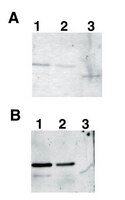MicroRNA miR-133b is essential for functional recovery after spinal cord injury in adult zebrafish.
Young-Mi Yu,Kurt M Gibbs,Jonathan Davila,Neil Campbell,Simon Sung,Tihomira I Todorova,Seiji Otsuka,Hatem E Sabaawy,Ronald P Hart,Melitta Schachner
The European journal of neuroscience
33
2011
显示摘要
MicroRNAs (miRNAs) play important roles during development and also in adult organisms by regulating the expression of multiple target genes. Here, we studied the function of miR-133b during zebrafish spinal cord regeneration and show upregulation of miR-133b expression in regenerating neurons of the brainstem after transection of the spinal cord. miR-133b has been shown to promote tissue regeneration in other tissue, but its ability to do so in the nervous system has yet to be tested. Inhibition of miR-133b expression by antisense morpholino (MO) application resulted in impaired locomotor recovery and reduced regeneration of axons from neurons in the nucleus of the medial longitudinal fascicle, superior reticular formation and intermediate reticular formation. miR-133b targets the small GTPase RhoA, which is an inhibitor of axonal growth, as well as other neurite outgrowth-related molecules. Our results indicate that miR-133b is an important determinant in spinal cord regeneration of adult zebrafish through reduction in RhoA protein levels by direct interaction with its mRNA. While RhoA has been studied as a therapeutic target in spinal cord injury, this is the first demonstration of endogenous regulation of RhoA by a microRNA that is required for spinal cord regeneration in zebrafish. The ability of miR-133b to suppress molecules that inhibit axon regrowth may underlie the capacity for adult zebrafish to recover locomotor function after spinal cord injury. | 21447094
 |
A highly conserved regulatory element controls hematopoietic expression of GATA-2 in zebrafish.
Yang, Z; Jiang, H; Zhao, F; Shankar, DB; Sakamoto, KM; Zhang, MQ; Lin, S
BMC developmental biology
7
97
2007
显示摘要
GATA-2 is a transcription factor required for hematopoietic stem cell survival as well as for neuronal development in vertebrates. It has been shown that specific expression of GATA-2 in blood progenitor cells requires distal cis-acting regulatory elements. Identification and characterization of these elements should help elucidating transcription regulatory mechanisms of GATA-2 expression in hematopoietic lineage.By pair-wise alignments of the zebrafish genomic sequences flanking GATA-2 to orthologous regions of fugu, mouse, rat and human genomes, we identified three highly conserved non-coding sequences in the genomic region flanking GATA-2, two upstream of GATA-2 and another downstream. Using both transposon and bacterial artificial chromosome mediated germline transgenic zebrafish analyses, one of the sequences was established as necessary and sufficient to direct hematopoietic GFP expression in a manner that recapitulates that of GATA-2. In addition, we demonstrated that this element has enhancer activity in mammalian myeloid leukemia cell lines, thus validating its functional conservation among vertebrate species. Further analysis of potential transcription factor binding sites suggested that integrity of the putative HOXA3 and LMO2 sites is required for regulating GATA-2/GFP hematopoietic expression.Regulation of GATA-2 expression in hematopoietic cells is likely conserved among vertebrate animals. The integrated approach described here, drawing on embryological, transgenesis and computational methods, should be generally applicable to analyze tissue-specific gene regulation involving distal DNA cis-acting elements. | 17708765
 |









